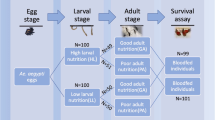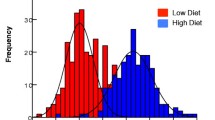Abstract
Food quality and quantity serve as the basis for cycling of key chemical elements in trophic interactions; yet the role of nutrient stoichiometry in shaping host–pathogen interactions is under appreciated. Most of the emergent mosquito-borne viruses affecting human health are transmitted by mosquitoes that inhabit container systems during their immature stages, where allochthonous input of detritus serves as the basal nutrients. Quantity and type of detritus (animal and plant) were manipulated in microcosms containing newly hatched Aedes aegypti mosquito larvae. Adult mosquitoes derived from these microcosms were allowed to ingest Zika virus-infected blood and then tested for disseminated infection, transmission, and total nutrients (percent carbon, percent nitrogen, ratio of carbon to nitrogen). Treatments lacking high-quality animal (insect) detritus significantly delayed development. Survivorship to adulthood was closely associated with the amount of insect detritus present. Insect detritus was positively correlated with percent nitrogen, which affected Zika virus infection. Disseminated infection and transmission decreased with increasing insect detritus and percent nitrogen. We provide the first definitive evidence linking nutrient stoichiometry to arbovirus infection and transmission in a mosquito using a model system of invasive Ae. aegypti and emergent Zika virus.







Similar content being viewed by others
References
Aalto SL, Decaestecker E, Pulkkinen K (2015) A three-way perspective of stoichiometric changes on host-parasite interactions. Trends Parasitol 31:333–340
Alto BW, Lounibos LP, Higgs S, Juliano SA (2005) Larval competition differentially affects arbovirus infection in Aedes mosquitoes. Ecology 86:3279–3288
Alto BW, Reiskind MH, Lounibos LP (2008) Size alters susceptibility of vectors to dengue virus infection and dissemination. Am J Trop Med Hyg 79:688–695
Alto BW, Muturi EJ, Lampman RL (2012) Effects of nutrition and density in Culex pipiens. Med Vet Entomol 26:396–406
Alto BW, Connelly CR, O’Meara GF, Hickman D, Karr N (2014) Reproductive biology and susceptibility of Florida Culex coronator to infection with West Nile virus. Vector Borne Zoonotic Dis 14(8):606–614
Bara J, Rapti Z, Cáceres CE, Muturi EJ (2014) Effect of larval competition on extrinsic incubation period and vectorial capacity of Aedes albopictus for dengue virus. PLoS One 10(5):e0126703. https://doi.org/10.1371/journal.pone.0126703
Beldomenico PM, Begon M (2010) Disease spread, susceptibility and infection intensity: vicious circles? Trends Ecol Evol 25(1):21–27
Borer ET, Laine AL, Seabloom EW (2016) A multiscale approach to plant disease using the metacommunity concept. Annu Rev Phytopathol 54:397–418
Boyer S, Calvez E, Chouin-Carneiro T, Diallo D, Failloux A-B (2018) An overview of mosquito vectors of Zika virus. Microbes Infect 11–12:646–660
Briegel H (1990) Metabolic relationship between female body size, reserves, and fecundity of Aedes aegypti. J Insect Physiol 36:165–172
Brunner FS, Schmid-Hempel P, Barribeau SM (2014) Protein-poor diet reduces host-specific immune gene expression in Bombus terrestris. Proc R Soc B 281:20140128
Bustin SA (2000) Absolute quantification of mRNA using real-time reverse transcription polymerase chain reaction assays. J Mol Endocrinol 25:169–193
Carpenter SR (1983) Resource limitation of larval treehole mosquitoes subsisting on beech detritus. Ecology 64:219–223
Clements AN (2012) The biology of mosquitoes. Transmission of viruses and interactions with bacteria, vol 3. CABI, Oxford
Coffey LL, Failloux A-B, Weaver SC (2014) Chikungunya virus-vector interactions. Viruses 6:4628–4663
Cornet S, Bichet C, Larcombe S, Faivre B, Sorci G (2014) Impact of host nutritional status on infection dynamics and parasite virulence in a bird-malaria system. J Anim Ecol 83:256–265
Cotter SC, Simpson SJ, Raubenheimer D, Wilson K (2011) Macronutrient balance mediates trade-offs between immune function and life history traits. Funct Ecol 25:186–198
Frost PC, Ebert D, Smith VH (2008) Bacterial infection changes the elemental composition of Daphnia magna. J Anim Ecol 77:1265–1272
Da-Silva Araújo M, Gil LHS, de Almeida e-Silva A (2012) Larval food quantity affects development time, survival and adult biological traits that influences the vectorial capacity of Anopheles darlingi under laboratory conditions. Malar J 11:261
Green BS, McCormick MI (2005) Maternal and paternal influences determine size, growth and performance in tropical reef fish larvae. Mar Ecol Prog Ser 289:263–272
Grill CP, Juliano SA (1996) Predicting species interactions based on behaviour: predation and competition in container-dwelling mosquitoes. J Anim Ecol 65:63–76
Grimstad PR, Haramis LD (1984) Aedes triseriatus (Diptera: Culicidae) and La Crosse virus III. Enhanced oral transmission by nutrition-deprived mosquitoes. J Med Entomol 21:249–256
Grimstad PR, Walker ED (1991) Aedes triseriatus (Diptera: Culicidae) and La Crosse virus IV. Nutritional deprivation of larvae affects the adult barriers to infection and transmission. J Med Entomol 28:378–386
Gubler DJ (1998) Dengue and dengue hemorrhagic fever. Clin Microbiol Rev 11:480–496
Haramis L Larval nutrition and adult ecology. Mosquito ecology: In: Lounibos L.P.,Rey J.(eds.) Proceedings of a Symposium pp. 431-439. University of Florida Press, Gainesville (1985)
Hillyer JF (2010) Mosquito immunity. Adv Exp Med Biol 708:218–238
Hillyer JF, Estéves-Lao TY (2010) Nitric oxide is an essential component of the hemocyte-mediated mosquito immune response against bacteria. Dev Comp Immunol 34:141–149
Howick VM, Lazzaro BP (2014) Genotype and diet shape resistance and tolerance across distinct phases of bacterial infection. BMC Evol Biol 14:56
Juliano SA (1998) Species introduction and replacement among mosquitoes: interspecific resource competition or apparent competition? Ecology 79:255–268
Kauffman E, Payne A, Franke MA, Schmid MA, Harris E, Kramer LD (2017) Rearing of Culex spp. and Aedes spp. mosquitoes. Bio Protoc 7:e2542
Kingsolver JG, Woods HA, Buckley LB, Potter KA, MacLean HJ, Higgins JK (2011) Complex life cycles and the responses of insects to climate change. Int Comp Biol 51:719
Kling LJ, Juliano SA, Yee DA (2007) Larval mosquito communities in discarded vehicle tires in a forested and unforested site: detritus type, amount, and water nutrient differences. J Vector Ecol 32:207–217
Klowden MJ (1986) Effects of sugar deprivation on the host-seeking behaviour of gravid Aedes aegypti mosquitoes. J Insect Physiol 32:479–483
Lee KP, Cory JS, Wilson K, Raubenheimer D, Simpson SJ (2006) Flexible diet choice offsets protein costs of pathogen resistance in a caterpillar. Proc R Soc B 273:823–829
Lee KP, Simpson SJ, Wilson K (2008) Dietary protein quality influences melanization and immune function in an insect. Funct Ecol 22:1052–1061
Livdahl TP, Sugihara G (1984) Non-linear interactions of populations and the importance of estimating per capita rates of change. J Anim Ecol 53:573–580
McCann S, Day JF, Allan S, Lord CC (2009) Age modifies the effect of body size on fecundity in Culex quinquefasciatus Say (Diptera: Culicidae). J Vector Ecol 34:174–181
McCormick MI, Gagliano M (2009) Carry-over effects—the importance of a good start. In: Proceedings of the 11th international coral reef symposium, Ft. Lauderdale, Florida, July 2008. From: 11th international coral reef symposium 2008, 07 July—11 July 2008, Fort Lauderdale, FL, USA
Murrell EG, Juliano SA (2008) The role of detritus type in interspecific competition and population distributions of Aedes aegypti and Aedes albopictus (Diptera: Culicidae). J Med Entmol 45:375–383
Muturi EJ, Kim CH, Alto BW, Berenbaum MR, Schuler MA (2011) Larval environmental stress alters Aedes aegypti competence for Sindbis virus. Trop Med Int Health 16:955–964
Nasci RS (1986) The size of emerging and host-seeking Aedes aegypti and the relation of size to blood-feeding success in the field. J Am Mosq Control Assoc 2:61–62
Nasci RS (1991) Influence of larval and adult nutrition on biting persistence in Aedes aegypti (Diptera: Culicidae). J Med Entomol 28:522–526
Patrican LA, DeFoliart GR (1985) Lack of adverse effect of transovarially acquired La Crosse virus infection on the reproductive capacity of Aedes triseriatus (Diptera: Culicidae). J Med Entomol 22:604–611
Paulson SL, Hawley WA (1991) Effect of body size on the vector competence of field and laboratory populations of Aedes triseriatus for La Crosse virus. J Am Mosq Control Assoc 7:170–175
Steinwascher K (1982) Relationship between pupal mass and adult survivorship and fecundity for Aedes aegypti. Environ Entomol 11:150–153
Takken W, Klowden MJ, Chambers GM (1998) Effect of body size on host seeking and blood meal utilization in Anopheles gambiae sensu stricto (Diptera: Culicidae): the disadvantage of being small. J Med Entomol 35:639–645
Telang A, Qayum AA, Parker A, Sacchetta BR, Byrnes GR (2012) Larval nutritional stress affects vector immune traits in adult yellow fever mosquito Aedes aegypti (Stegomyia aegypti). Med Vet Entomol 26:271–281
Turell MJ, Gargan TP, Bailey C (1984) Replication and dissemination of Rift Valley fever virus in Culex pipiens. Am J Trop Med Hyg 33:176–181
Vantaux A, Lefèvre T, Cohuet A, Dabiré KR, Roche B, Roux O (2016a) Larval nutritional stress affects vector life history traits and human malaria transmission. Sci Rep 6:1–10
Vantaux A, Ouattarra I, Lefèvre T, Dabiré KR (2016b) Effects of larvicidal and larval nutritional stresses on Anopheles gambiae development, survival and competence for Plasmodium falciparum. Parasit Vectors 9:1–11
Wink DA, Hines HB, Cheng RYS, Switzer CH, Flores-Santana W, Vitek MP, Ridnour LA, Colton CA (2011) Nitric oxide and redox mechanisms in the immune response. J Leukoc Biol 89:791–873
Winters AE, Yee DA (2012) Variation in performance of two co-occurring mosquito species across diverse resource environments: insights from nutrient and stable isotope analyses. Ecol Entomol 37:56–64
Yee DA (2008) Tires as habitats for mosquitoes: a review of studies within the eastern United States. J Med Entomol 45:581–593
Yee DA, Juliano SA (2006) Consequences of detritus type in an aquatic microsystem: effects on water quality, micro-organisms and performance of the dominant consumer. Freshw Biol 51:448–459
Yee DA, Juliano SA (2012) Concurrent effects of resource pulse amount, type, and frequency on community and population properties of consumers in detritus-based systems. Oecologia 169:511–522
Yee DA, Kaufman MG, Ezeakacha NF (2015) How diverse detrital environments influence nutrient stoichiometry between males and females of the co-occurring container mosquitoes Aedes albopictus, Ae. aegypti, and Culex quinquefasciatus. PLoS One 10(8):1–19
Zhang S, He G, Xu L, Lin Q, Zhang S (1993) Effects of larval nutrition on susceptibility of Aedes albopictus to dengue 2 virus. Arbovirus Res Aust 6:44–48
Acknowledgements
An isolate of Zika virus was kindly provided by the Centers for Disease Control and Prevention. We thank A. Carels, B. Eastmond, S. Ortiz, K. Wiggins, and R. Zimler for technical support with experiments. K. Kuehn provided technical support for nutrient analysis of mosquitoes.
Author information
Authors and Affiliations
Contributions
DAY and BWA conceived of and designed the project. ASP and SKB carried out mosquito husbandry, viral propagation, molecular work and collected project data. CLD performed the nutrient analyses and mosquito mass measurements. DAY analyzed and interpreted the data with BWA. ASP, BWA, DAY and CLD wrote and edited the manuscript. All authors gave final approval for manuscript publication.
Corresponding author
Additional information
Communicated by Stefan Scheu.
This study is the first to link nutrient stoichiometry of whole body mosquitoes, particularly nitrogen limitation in the larval stage of Aedes aegypti, to the enhanced transmission of Zika virus. Our findings help bridge the gap in the understanding of larval nutrition in relation to adult interaction with pathogens.
Rights and permissions
About this article
Cite this article
Paige, A.S., Bellamy, S.K., Alto, B.W. et al. Linking nutrient stoichiometry to Zika virus transmission in a mosquito. Oecologia 191, 1–10 (2019). https://doi.org/10.1007/s00442-019-04429-6
Received:
Accepted:
Published:
Issue Date:
DOI: https://doi.org/10.1007/s00442-019-04429-6




